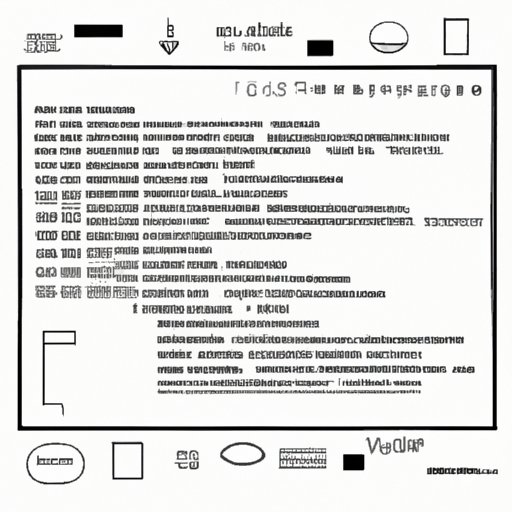
Introduction
Centering a div using CSS can be a frustrating experience, especially for beginners. It’s a common problem that website designers and developers encounter, but it’s not always easy to find the best solution. In this article, we will explore different techniques, tips, and tricks for centering a div using CSS. This guide is designed for web developers, designers, and anyone who wants to learn how to achieve perfect center alignment in their web design layouts.

The Quick Guide to Centering a Div with CSS Flexbox
CSS flexbox is a powerful layout tool that allows developers to create dynamic and responsive layouts with ease. It’s ideal for centering a div because it provides a more efficient and flexible solution than traditional CSS methods such as margin auto. To center a div with flexbox, you need to:
- Create a container div with display:flex;
- Add the justify-content:center; property to the container div;
- Add the align-items:center; property to the container div;
- Finally, add the div that you want to center inside the container div.
Here is an example code:
.container {
display: flex;
justify-content: center;
align-items: center;
}
This will center any div inside the container div. Here is an example screenshot of a centered div using CSS flexbox:

Achieving Perfect Center Alignment: A Step-by-Step Tutorial for Centering a Div with Grid
CSS grid is another great layout option to center a div. It provides a two-dimensional grid system that allows developers to align and position elements with ease. To center a div with grid, you need to:
- Create a container div with display:grid;
- Add the justify-content:center; property to the container div;
- Add the align-items:center; property to the container div;
- Finally, add the div that you want to center inside the container div.
Here is an example code:
.container {
display: grid;
justify-content: center;
align-items: center;
}
Here is an example screenshot of a centered div using CSS grid:

5 Common Techniques for Centering a Div in CSS
There are many techniques to center a div in CSS, but five of the most popular are:
- Using margin:auto;
- Using text-align:center;
- Using absolute positioning;
- Using transform:translate();
- Using display:table;
Each technique has its own pros and cons. For example, margin:auto works well for horizontally centering a div, but it doesn’t work for vertical centering. Absolute positioning works well for centering a div both horizontally and vertically, but it can be difficult to use for responsive design layouts. Here are some example codes and screenshots for each technique:
- Using margin:auto;
.container {
width:400px;
height:400px;
background-color:gray;
margin:auto;
}

.container {
display:inline-block;
text-align:center;
background-color:gray;
padding:20px;
}

.container {
position:relative;
}
.content {
position:absolute;
top:50%;
left:50%;
transform:translate(-50%, -50%);
background-color:gray;
width:200px;
height:200px;
}

.container {
position:relative;
}
.content {
position:absolute;
top:50%;
left:50%;
transform:translate(-50%, -50%);
background-color:gray;
width:200px;
height:200px;
}

.wrapper {
display:table;
margin:auto;
}
.content {
display:table-cell;
vertical-align:middle;
background-color:gray;
width:200px;
height:200px;
}

How to Center a Div Horizontally and Vertically in CSS
Centering a div both horizontally and vertically is a bit more challenging than just centering in one direction. Here are the steps you need to follow:
- Create a container div;
- Add the display:flex; property to the container div;
- Add the justify-content:center; property to the container div;
- Add the align-items:center; property to the container div;
- Add the height and width properties to the container div;
- Add the div that you want to center inside the container div;
- Add the position:relative; property to the inner div;
- Add the top:50%; property to the inner div;
- Add the left:50%; property to the inner div;
- Add the transform: translate(-50%, -50%); property to the inner div;
Here is an example code:
.container {
display: flex;
justify-content: center;
align-items: center;
width: 100%;
height: 100vh;
}
.inner {
position:relative;
top: 50%;
left: 50%;
transform:translate(-50%,-50%);
}
And here is an example screenshot of a div centered both horizontally and vertically:

Mastering CSS Positioning to Center Your Div
CSS positioning can be used to achieve center alignment as well. There are three CSS positioning properties that can be used for centering a div:
- position:absolute;
- position:relative;
- position:fixed;
To center a div, you need to:
- Create a container div;
- Add the position:relative; property to the container div;
- Add the position:absolute; property to the inner div;
- Add the top:50%; property to the inner div;
- Add the left:50%; property to the inner div;
- Add the transform:translate(-50%, -50%); property to the inner div;
Here is an example code:
.container {
position:relative;
}
.inner {
position:absolute;
top:50%;
left:50%;
transform: translate(-50%, -50%);
}
Here is an example screenshot of a centered div using CSS positioning:

Responsive Design Tricks: How to Center a Div on Any Screen Size
Responsive design is an important consideration when centering a div. Techniques that work on one screen size may not work on another. Here are some tips and tricks for ensuring your div is centered on any screen size:
- Use CSS media queries to adjust your centering techniques for different screen sizes;
- Consider using a responsive CSS framework such as Bootstrap or Foundation;
- Use percentages instead of pixels for your width and height properties.
By following these tips and tricks, you can ensure that your div is centered on any screen size.
Tips and Tricks for Centering a Div in CSS Without Using Margin Auto
While margin:auto is a popular technique for centering a div, it’s not always the best option. Here are some alternative techniques:
- Use CSS flexbox or grid;
- Use transform:translate();
- Use CSS positioning;
- Use text-align:center;
Each technique has its pros and cons, but they can all be used to center a div without using margin auto.
Conclusion
Centering a div using CSS can be a challenge, but by following the techniques, tips, and tricks outlined in this guide, you can achieve perfect center alignment in your web design layouts. Whether you’re using flexbox, grid, CSS positioning, or one of the many other techniques, make sure to test your layout on different screen sizes and devices to ensure that your div is centered correctly.
For further reading and resources, check out the following:





